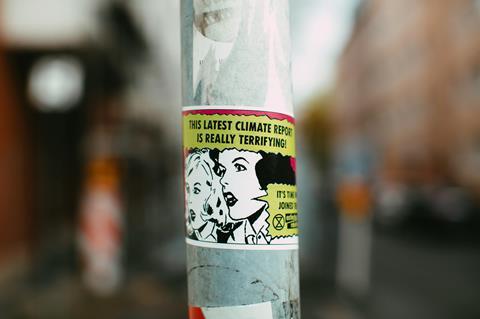With governments under pressure to deliver on Net Zero targets, doomism in climate communication threatens to backfire and deter audiences from taking action. But microbiology’s stories of hope could be the inspiration we need, says Linda Stewart.
Do you want the good news or the bad news first? The good news: carbon emissions may peak this year, thanks to advances in renewable energy and the accelerating uptake of electric cars, particularly in China. The bad news, according to climate scientist Michael Mann, is that even if this happens, emissions must come down further — and quickly — if we are to limit the long-term temperature rise to 1.5°C above pre-industrial levels. In fact, a 2023 report revealed that 20 of 35 planetary vital signs are at record extremes.

This COP29 summit is pivotal. Simon Stiell, the UN Climate Change Executive Secretary, warned at COP28 that governments and businesses must transform pledges into real action, stating that the ‘end of the fossil fuel era’ is near. While the UK’s new Labour government is setting ambitious targets, such as delivering clean power by 2030, a significant challenge remains in convincing the public to embrace these goals. With 45% of Britons citing the cost of living crisis as their top electoral issue in a recent YouGov poll, climate change ranked much lower at just 14%.
So, how should the government approach public information campaigns on climate awareness at a time when people are preoccupied with immediate pressures?
The fear approach
Aristotle’s rhetorical triangle — ethos (credibility), logos (logic), and pathos (emotion) — remains central to persuasive communication. In the context of public messaging, fear appeals, which play on pathos, have long been a popular tactic. Fear-based messages, highlighting threats like physical harm or injury, tend to be highly memorable. This is partly due to the brain’s natural prioritisation of fear responses over reasoning faculties, making fear an effective motivator.
Climate change, with its apocalyptic imagery — from wildfires to rising sea levels — seems to offer a powerful fear appeal that could push audiences toward greener lifestyles. Successful fear-based campaigns in other areas, such as the USA’s Truth anti-smoking campaign, which led to a 22% decline in youth smoking rates, or the UK’s infamous 1985 AIDS campaign, illustrate the power of fear in driving behavioural change.
Doomism can backfire
However, while fear can heighten awareness, it can also backfire. Studies show that if the fear appeal is too intense, it may overwhelm people and lead to avoidance or denial. During the COVID-19 pandemic, fear-based messages were effective initially, but they quickly lost impact as people became fatigued by the constant barrage of negative information. This can lead to the so-called ”boomerang effect,” where people feel helpless or desensitised and, instead of taking action, retreat into denial or doomism.

Mann has also observed how doomism, often promoted by vested interests, can be a powerful tool in maintaining the status quo. If people believe that nothing can be done to prevent catastrophic climate change, they may ask themselves: why try? That’s why Mann emphasises the importance of pairing urgency with a sense of agency. “We must act now to avert catastrophic outcomes,” he argues, “but there is still time to act.”
Positive messaging
To combat the paralysing effects of fear, messages that inspire hope and show efficacy are crucial. These can focus on what individuals can do to make a difference (internal efficacy), what powerful institutions are doing (external efficacy), and the effectiveness of solutions already in place (response efficacy).
In fact, positive messaging, particularly around scientific breakthroughs, offers a rich and underutilised resource. Scientists across the globe are working on revolutionary solutions to tackle climate change. For instance, microbiologist Nasmille Larke-Mejía is researching microbes that can consume isoprene, a compound released by plants that can exacerbate climate impacts in cities. Her work is just one example of how microbiology could help mitigate climate change effects.

Similarly, Arpita Bose is exploring how purple bacteria could be engineered to produce biodegradable plastics without adding carbon dioxide to the atmosphere. Innovations like these demonstrate that far from being passive victims of climate change, we have the tools to make a significant difference.
Solutions from microbiology
Petr Heděnec of Universiti Malaysia Terengganu explores how forests can shape microbial life in the soil that could be exploited as a major carbon sink that also regulates greenhouse gas emissions.
“Through thoughtful forest management, we can create ecosystems that naturally reduce carbon emissions and store more carbon in the soil. Success stories like this show how we can work with nature to mitigate negative consequences of climate change,” he says.
READ MORE: Overlooked pathway could be game-changer for ecosystem climate services
Professor Don A Cowan, Director of the Centre for Microbial Ecology and Genomics at the University of Pretoria and AMI Global Ambassador for South Africa, looks at how microbes in and around the roots of plants can help them combat the negative effects of desiccation or pathogen attack and how these communities may change under climate impacts.
“This is an important research area, not the least because the answers may allow us to control, or supplement, the rhizospheric (root microbe) populations, to the benefit of the plant hosts,” he says.
Fungi in space
Meanwhile, Marta Filipa Simões, Assistant Professor at the Chinese State Key Laboratory of Lunar and Planetary Sciences, at the Macau University of Science and Technology, is conducting fascinating research on how fungi survive in harsh space environments which could help drive innovative solutions to address climate change on Earth, such as bioremediation and sustainable agriculture.
“While it’s important to communicate the seriousness of climate change, I believe that constant negative messaging is leading to feelings of hopelessness and inaction. Positive stories about scientific advancements and practical solutions can inspire people and show that there are effective ways to combat climate change,” Marta says.
“If we focus on what we can do and the progress of what is being made, we might be able to motivate more individuals and communities to take action.”
Groundbreaking discoveries
This summer alone, a wealth of groundbreaking discoveries in applied microbiology have been announced , each with the potential to change the world - microbes engineered to transform carbon dioxide into pharmaceutical chemicals, organisms that can metamorphose municipal solid waste into biofuels, algae that can be deployed as a renewable energy source that mops up greenhouse gases, gut microbiome manipulations that can reduce methane emissions from cattle digestion.
These scientists exemplify how hope and ingenuity can provide an antidote to doomism. Instead of shutting down in the face of overwhelming climate threats, they are focused on developing practical, actionable solutions that can inspire both governments and individuals to act.
Balancing fear with efficacy
The UK’s Behavioural Insights Team highlights three elements for a successful Net Zero narrative: positive messaging, clear asks, and highlighting the co-benefits of environmental action. Positive stories, like the scientific innovations mentioned earlier, provide a sense of control and efficacy. These stories can address all three components of Aristotle’s rhetorical triangle — they are logical (logos), credible (ethos), and, perhaps most importantly, emotionally resonant (pathos).
A balanced communication strategy, combining fear and hope, is crucial. Practitioners have increasingly found that fear works best when coupled with a strong sense of efficacy — when people understand the severity of the threat but also believe they have the power to take meaningful action. This combination has the potential to motivate green behaviour shifts.

For example, Nudge Theory, which gained attention during the pandemic, could be adapted to encourage climate-friendly actions. Pointing out that many scientists cycle to work or have reduced their meat consumption might inspire people to make similar choices, without feeling coerced.
The COM-B model (Capability, Opportunity, Motivation – Behaviour) emphasised by the Cabinet Office’s behavioural science team supports this approach. For an individual to adopt a behaviour, they must not only be motivated but also believe they have the capability and opportunity to act. Positive scientific stories, alongside clear, achievable green actions, can provide both the motivation and belief in the ability to make a difference.
The case for hope
Ultimately, the most effective climate communication will strike a balance between fear and hope. While we must communicate the severity of the climate crisis, we must also highlight the power of science and human ingenuity to overcome it. Positive stories of scientific breakthroughs — like the work of microbiologists addressing climate challenges — can serve as a potent counterbalance to doomism, showing that meaningful action is still within our grasp.
By sandwiching urgent warnings between hopeful scientific developments and a checklist of achievable actions, communicators can create a narrative of both fear and empowerment. In these times of increasing negativity, such a narrative might be exactly what we need to inspire action.
Linda Stewart is Public Relations and Communications Manager with Applied Microbiology International.







No comments yet